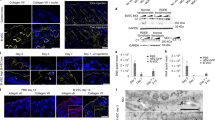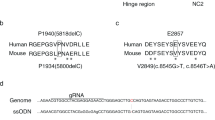Abstract
Dystrophic epidermolysis bullosa (DEB) is a family of inherited mechano-bullous disorders caused by mutations in the human type VII collagen gene (COL7A1). Individuals with DEB lack type VII collagen and anchoring fibrils, structures that attach epidermis and dermis. The current lack of treatment for DEB is an impetus to develop gene therapy strategies that efficiently transfer and stably express genes delivered to skin cells in vivo. In this study, we delivered and expressed full-length type VII collagen using a self-inactivating minimal lentivirus-based vector. Transduction of lentiviral vectors containing the COL7A1 transgene into recessive DEB (RDEB) keratinocytes and fibroblasts (in which type VII collagen was absent) resulted in persistent synthesis and secretion of type VII collagen. Unlike RDEB parent cells, the gene-corrected cells had normal morphology, proliferative potential, matrix attachment and motility. We used these gene-corrected cells to regenerate human skin on immune-deficient mice. Human skin regenerated by gene-corrected RDEB cells had restored expression of type VII collagen and formation of anchoring fibrils at the dermal–epidermal junction in vivo. These studies demonstrate that it is possible to restore type VII collagen gene expression in RDEB skin in vivo.
This is a preview of subscription content, access via your institution
Access options
Subscribe to this journal
Receive 12 print issues and online access
$209.00 per year
only $17.42 per issue
Buy this article
- Purchase on SpringerLink
- Instant access to full article PDF
Prices may be subject to local taxes which are calculated during checkout






Similar content being viewed by others
References
Uitto, J. & Christiano, A.M. Molecular basis for the dystrophic forms of epidermolysis bullosa: mutations in the type VII collagen gene. Arch. Dermatol. Res. 287, 16–22 (1994).
Burgeson, R.E. Type VII collagen, anchoring fibrils, and epidermolysis bullosa. J. Invest. Dermatol. 101, 252–255 (1993).
Sakai, L.Y., Keene, D.R., Morris, N.P. & Burgeson, R.E. Type VII collagen is a major structural component of anchoring fibrils. J. Cell Biol. 103, 1577–1586 (1986).
Christiano, A.M., Greenspan, D.S., Lee, S. & Uitto, J. Cloning of human type VII collagen: complete primary sequence of the α1(VIII) chain and identification of intragenic polymorphisms. J. Biol. Chem. 26, 20256–20262 (1994).
Christiano, A.M. & Uitto, J. Impact of molecular genetic diagnosis on dystrophic epidermolysis bullosa. Curr. Opin. Dermatol. 3, 225–232 (1996).
Briggaman, R.A. & Wheeler, C.E. Jr. The epidermal–dermal junction. J. Invest. Dermatol. 65, 71–84 (1975).
Morgan, R.A. & Anderson, W.F. Human gene therapy. Ann. Rev. Biochem. 62, 191–217 (1993).
Anderson, W.F. Human gene therapy. Nature 392, 25–30 (1998).
Naldini, L., Blomer, U., Gage, F.H., Trono, D. & Verma, I.M. Efficient transfer, integration, and sustained long-term expression of the transgene in adult rat brains injected with a lentiviral vector. Proc. Natl Acad. Sci. USA 93, 11382–11388 (1996).
Kuhn, U., Terunuma, A., Pfutzner, W., Foster, R.A. & Vogel, C. In vivo assessment of gene delivery to keratinocytes by lentiviral vectors. J. Virol. 76, 1496–1504 (2002).
Sakoda, T., Kasahara, N., Hamamori, Y. & Kedes, L. A high-titer lentiviral production system mediates efficient transduction of differentiated cells including beating cardiac myocytes. J. Mol. Cell Cardiol. 31, 2037–2047 (1999).
Naldini, L. Lentivirus as gene transfer agents for delivery to non-dividing cells. Curr. Opin. Biotechnol. 9, 457–463 (1998).
Chen, M. et al. Development and characterization of a recombinant truncated type VII collagen “minigene”: implication for gene therapy of dystrophic epidermolysis bullosa. J. Biol. Chem. 275, 24429–24435 (2000).
Wang, C., Nelson, C.F., Brinkman, A.M., Miller, A.C. & Hoeffler, W.K. Spontaneous cell sorting of fibroblasts and keratinocytes creates an organotypic human sin equivalent. J. Invest. Dermatol. 114, 674–680 (2000).
Fenjves, E.S., Yao, S.N., Kurachi, K. & Taichman, L.B. Loss of expression of a retrovirus-transduced gene in human keratinocytes. J. Invest. Dermatol. 106, 576–581 (1996).
Choate, K. & Khavari, P.A. Sustainability of keratinocyte gene transfer and cell survival in vivo. Hum. Gene Ther. 8, 895–901 (1997).
Robbins, P.B. et al. Increased probability of expression from modified retroviral vectors in embryonal stem cells and embryonal carcinoma cells. J. Virol. 71, 9466–9474 (1997).
Robbins, P.B. et al. Consistent, persistent expression from modified retroviral vectors in murine hematopoietic stem cells. Proc. Natl Acad. Sci. USA 95, 10182–10187 (1998).
Boyce, S.T. & Ham, R.G. Calcium-regulated differentiation of normal human epidermal keratinocytes in chemically defined clonal culture and serum-free serial culture. J. Invest. Dermatol. 81 Suppl., 33S–44S (1983).
O'Keefe, E.J. & Chiu, M.L. Stimulation of thymidine incorporation in keratinocytes by insulin, epidermal growth factor, and placental extract: comparison with cell number to assess growth. J. Invest. Dermatol. 90, 2–7 (1988).
Halbert, C.L., Demers, G.W. & Galloway, D.A. The E6 and E7 genes of human papillomavirus type 6 have weak immortalizing activity in human epithelial cells. J. Virol. 66, 2125–2134 (1992).
Sastry, L., Johnson, T., Hobson, M.J., Smucker, B. & Cornetta, K. Titering lentiviral vectors: comparison of DNA, RNA and marker expression methods. Gene Ther. 9, 1155–1162 (2002).
Cui, Y., Iwakuma, T. & Chang, L.J. Contributions of viral splice sites and cis-regulatory elements to lentivirus vector function. J. Virol. 73, 6171–6176 (1999).
Sirven, A. et al. The human immunodeficiency virus type-1 central DNA flap is a crucial determinant for lentiviral vector nuclear import and gene transduction of human hematopoietic stem cells. Blood 96, 4103–4110 (2000).
Zufferey, R. et al. Self-inactivating lentivirus vector for safe and efficient in vivo gene delivery. J. Virol. 72, 9873–9880 (1998).
Albrecht-Buehler, G. The phagokinetic tracks of 3T3 cells. Cell 11, 395–404 (1977).
Woodley, D.T., Bachmann, P.M. & O'Keefe, E.J. Laminin inhibits human keratinocyte migration. J. Cell Physiol. 136, 140–146 (1988).
Chen, M., O'Toole, E.A., Li, Y.-Y. & Woodley, D.T. α2β1 integrin mediates dermal fibroblast attachment to type VII collagen via a 158-amino-acid segment of the NC1 domain. Exp. Cell Res. 249, 231–239 (1999).
Chen, M., Costa, F.K., Lindvay, C.R., Han, Y.P. & Woodley, D.T. The recombinant expression of full-length type VII collagen and characterization of molecular mechanisms underlying dystrophic epidermolysis bullosa. J. Biol. Chem. 277, 2118–2124 (2002).
Gammon, W.R., Briggaman, R.A., Inman, A.Q. III, Queen, L.L. & Wheeler, C.E. Differentiating anti-lamina lucida and anti-sublamina densa anti-BMZ antibodies by indirect immunofluorescence on 1.0 M sodium chloride-separated skin. J. Invest. Dermatol. 82, 139–144 (1984).
Acknowledgements
This work was supported by grants from the US National Institutes of Health to M.C. and D.T.W. M.C. was supported by a Dermatology Foundation Career Development Award and a Dermatology Foundation Research Grant. C.M. and N.K. are also funded in part by a grant from the US National Institutes of Health through the Molecular Biology Core/Virus Vector Subcore of the University of Southern California Research Center for Liver Diseases.
Author information
Authors and Affiliations
Corresponding author
Ethics declarations
Competing interests
The authors declare no competing financial interests.
Rights and permissions
About this article
Cite this article
Chen, M., Kasahara, N., Keene, D. et al. Restoration of type VII collagen expression and function in dystrophic epidermolysis bullosa. Nat Genet 32, 670–675 (2002). https://doi.org/10.1038/ng1041
Received:
Accepted:
Published:
Issue Date:
DOI: https://doi.org/10.1038/ng1041



